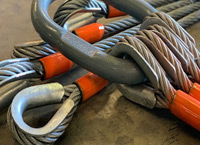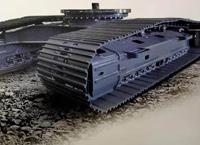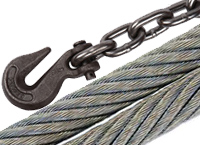- Hydraulic tools
- Construction Machinery
- Pump
- Ferguson tractor hydraulic pump repair(1)
- Roquet hydraulic pump repair(1)
- Komatsu WA470 hydraulic pump repair(1)
- New holland combine hydraulic pump repair(1)
- KATO crane hydraulic pump repair(1)
- D155 Komatsu hydraulic pump repair(1)
- CAT 988 loader hydraulic pump repair(1)
- Volvo L150E loader hydraulic pump repair(1)
- HEPCO bulldozer hydraulic pump repair(1)
- komatsu forklift hydraulic pump repair(1)
- Casappa hydraulic pump repair(1)
- Komatsu WA800 hydraulic pump repair(1)
- Toyota forklift hydraulic pump repair(1)
Hydraulic Pump Repair
Search Results For Hydraulic Pump Repair| hydraulicmarket |
| Iran |
| 021-55130771 |
Ferguson tractor hydraulic pump repair
Repairing the hydraulic pump of a Massey Ferguson 285 tractor is a highly specialized process that requires mechanical knowledge and precise tools. The pump is responsible for transmitting hydraulic oil pressure to the system, and any malfunction can reduce the efficiency of lifting arms and agricultural implements. Common failure symptoms include oil leakage, sudden pressure loss, and unusual noise during operation. Identifying these signs early and performing timely repairs prevents further damage to other hydraulic components.
During the repair of the Massey Ferguson 285 hydraulic pump, the internal parts such as gears, O-rings, and valves must be carefully inspected. Cleaning the components from oil residues and metallic deposits is essential, as contamination can cause wear and shorten the pump’s service life. Using high quality hydraulic oil that complies with the specifications of the Massey Ferguson tractor ensures reliable performance, especially under demanding working conditions.
After replacing or repairing the worn components of the Massey Ferguson 285 hydraulic pump, the system must be properly bled. Air bleeding prevents the formation of bubbles in the hydraulic circuit, ensuring smooth cylinder operation. A final performance test, including measuring the o
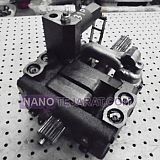
 | |
| hydraulicmarket | 021-55130771 |
| hydraulicmarket |
| Iran |
| 021-55130771 |
New holland combine hydraulic pump repair
The hydraulic pump of a New Holland combine is typically an axial piston type with a swash plate design or, in some models, a vane type with a flow capacity between 90 and 130 liters per minute. This pump can generate an operating pressure range of 220 to 260 bar and is mainly responsible for powering the steering system, cutting cylinders, and feeding mechanisms. Correct pump type selection and monitoring of output flow under heavy working conditions are crucial to prevent efficiency loss and hydraulic oil overheating.
The mounting location of the New Holland combine hydraulic pump is usually on the engine’s side, close to the main gearbox. This placement allows the pump to receive direct mechanical power from the drive shaft, and the connection is commonly made via a flange coupling. At this point, high-pressure lines and return hoses to the hydraulic reservoir are installed, which must be sealed with O-rings designed to withstand pressures up to 250 bar to avoid leakage.
Repairing the New Holland combine hydraulic pump involves disassembling internal components, inspecting pistons, valves, and bearings, and measuring tolerances precisely with a digital micrometer. If wear greater than 0.05 millimeters or cracks in the housing are detected, the affected parts must be re
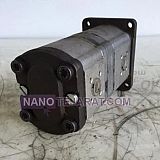
 | |
| hydraulicmarket | 021-55130771 |
| parsianrahbalandeh |
| Iran |
| 02155130771 |
Concrete machine hydraulic pump repair
The REXROTH A4VG concrete mixer boom hydraulic pump is an axial piston variable displacement type, capable of adjusting flow according to load requirements. Its nominal power reaches up to 75 kW, and flow rate ranges between 50 and 180 liters per minute. Maximum operating pressure is 350 bar, and oil temperature is controlled between 40 and 70 degrees Celsius under standard conditions. This pump supplies hydraulic force to lift cylinders and mixer rotation and requires precise monitoring of pressure, flow, and operating temperature.
The repair process includes complete disassembly of the pump body, inspection of the shaft and bearings, and checking pistons and gears. O-rings, seals, and gaskets are commonly replaced. Internal and external leakage tests, volumetric flow measurement, and output pressure verification are performed before and after repair. Adjusting the swashplate angle for accurate flow is essential. Using precision tools and hydraulic test equipment reduces repair errors to less than 2 percent.
Consumable parts include pistons, swashplate, shaft bearings, O-rings, and high-pressure washers. Repair costs depend on part condition and usually range between 25 and 40 percent of the new pump price. After reassembly, the pump is tested at standard pressures of 250�
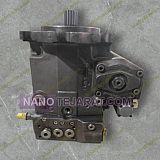
 | |
| parsianrahbalandeh | 02155130771 |
| hydraulicmarket |
| Iran |
| 021-55130771 |
Casappa hydraulic pump repair
The hydraulic pump of the backhoe loader brand CASAPPA is one of the key components of the hydraulic system, responsible for supplying the required flow and pressure of hydraulic oil. These pumps are usually gear or piston type, with flow capacities ranging from 60 to 120 liters per minute and operating pressures between 180 and 250 bar, providing high efficiency in energy transmission. The precise gear design and optimized sealing system significantly improve performance, reduce leakage, and increase the overall service life of mechanical components.
The main reasons for CASAPPA hydraulic pump failure are oil contamination, cavitation, overload, or high operating temperatures. Early signs of malfunction include pressure drops, unusual noise, and reduced cylinder movement speed. Continued operation with a damaged pump can lead to severe issues in valves and control systems, which drastically increase the overall repair costs. Timely maintenance and oil monitoring are essential to minimize these risks.
Repairing a CASAPPA hydraulic pump typically involves disassembly, inspection of internal wear surfaces, checking seals, and replacing O-rings and bearings. In cases of major damage to gears or pistons, replacement of main components becomes necessary. Repair costs usually ran
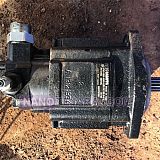
 | |
| hydraulicmarket | 021-55130771 |
| hydraulicmarket |
| Iran |
| 021-55130771 |
Roquet hydraulic pump repair
The Roquet hydraulic pump in backhoe loaders is usually of the gear or piston type, with a nominal flow rate of 60 to 120 liters per minute and a working pressure of 250 to 320 bar. These pumps are made of wear-resistant steel alloys and cast iron housings, which enhance service life and minimize deformation under cyclic loads. The internal design includes hardened gears or precisely machined pistons, assembled with tolerances of less than 5 microns.
In terms of mechanical performance, the Roquet pump can deliver stable power to the boom and bucket cylinders, achieving a volumetric efficiency above 92 percent. Ball bearings with a hardness of 60 HRC and seals made of NBR O-rings resistant to temperatures up to 120°C are used. Vibration levels under full load remain below 1.5 mm/s, reflecting the precision of the pump’s engineering.
Maintenance of Roquet hydraulic pumps in backhoe loaders involves checking gear or piston wear, controlling internal leakage, and replacing worn O-rings. If output flow decreases to less than 80 percent of the rated capacity, a 280-bar pressure test is required to determine efficiency loss. To extend pump life, it is recommended to replace the hydraulic filter every 2000 working hours and use standard ISO VG 46 oil. Employing original Roquet s
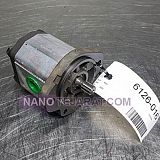
 | |
| hydraulicmarket | 021-55130771 |
| hydraulicmarket |
| Iran |
| 021-55130771 |
D155 Komatsu hydraulic pump repair
The hydraulic pumps in Komatsu bulldozer models D65, D85, and D155 are critical components that convert mechanical engine power into hydraulic energy, enabling efficient operation of the dozers blade, steering, and other functions. These pumps are typically piston-type, offering high efficiency and durability under demanding conditions.
fridayparts.com
For instance, the Komatsu D65PX-18 model is equipped with a piston-type hydraulic pump delivering a discharge flow of 248 liters per minute 65.5 U.S. gallons per minute at rated engine RPM. The relief valve setting is calibrated to 27.9 MPa approximately 4,050 psi, ensuring optimal pressure regulation within the hydraulic system. This configuration supports the Closed-Center Load Sensing System CLSS, which provides precise and responsive control for efficient simultaneous operations.
komatsu.com
+2
komatsu.com
+2
Similarly, the Komatsu D85-18 model features a piston-type hydraulic pump with a discharge flow capacity of 331 liters per minute 87.4 U.S. gallons per minute at rated engine RPM. The relief valve is set at 22.6 MPa approximately 3,270 psi, facilitating the CLSS for enhanced operational efficiency. These specifications ensure that the hydraulic system can handle the high demands of the dozers operations, provid
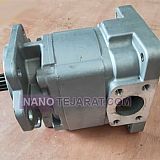
 | |
| hydraulicmarket | 021-55130771 |
| hydraulicmarket |
| Iran |
| 021-55130771 |
Komatsu WA470 hydraulic pump repair
The hydraulic pump of the Komatsu 470 wheel loader is an axial piston type with a swash plate, capable of operating at working pressures up to 320 bar. This pump supplies hydraulic power for the lift cylinders, steering system, and auxiliary hydraulic functions. The original brands commonly used are Komatsu or Kawasaki Japan, both known for precise engineering and long service life under demanding mining and construction conditions.
The head and flow rate of the Komatsu 470 hydraulic pump range between 280 and 320 liters per minute at 1800 rpm, depending on the model. The internal flow passages and control system are designed to optimize efficiency and reduce pressure loss. This high hydraulic capacity ensures smooth steering response and fast, stable movement of the lift arms, which is critical for loading and material handling operations.
The repair process of the 470 hydraulic pump begins with complete disassembly and cleaning of all components using a moisture-free industrial solvent. Critical parts such as pistons, cylinder block, bearings, and swash plate are then inspected with micrometer precision. If wear exceeds 0.02 millimeters, replacement or re-machining is performed. Finally, the pump is reassembled and tested at 300 bar pressure and nominal flow to verify pro
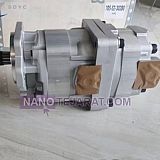
 | |
| hydraulicmarket | 021-55130771 |
| hydraulicmarket |
| Iran |
| 021-55130771 |
komatsu forklift hydraulic pump repair
Repairing the hydraulic pump of a Komatsu forklift involves accurately diagnosing faults, disassembling the pump, and inspecting internal components. Common issues include oil leakage, pressure loss, and unusual noise. Before repair, the hydraulic system should be drained and filters replaced to prevent contamination. Using precise tools and measuring pressure and flow during post-repair testing ensures system safety and optimal performance.
Komatsu forklift hydraulic pumps are typically gear-type or variable displacement piston pumps with high capacity. Pump pressure ranges from 100 to 200 bar depending on the forklift model, and flow rate is between 40 to 80 liters per minute. These technical specifications allow the pump to generate sufficient force to lift heavy loads and operate hydraulic cylinders. Proper pump selection and accurate adjustment of pressure and flow are critical for system efficiency and longevity.
During Komatsu hydraulic pump repair, attention must be paid to worn gears, pistons, and O-rings. Using standard hydraulic oil and replacing rotors and bushings when worn restores pressure and flow to factory specifications. Inspecting internal leaks and performing functional tests after assembly ensures the forklift’s hydraulic system operates efficiently
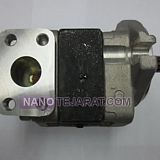
 | |
| hydraulicmarket | 021-55130771 |
| hydraulicmarket |
| Iran |
| 021-55130771 |
HEPCO bulldozer hydraulic pump repair
The hydraulic pump of a HEPCO bulldozer functions as the core of the hydraulic system, responsible for supplying the required pressure to cylinders and the steering unit. These pumps are typically axial piston type with variable displacement control, operating at pressures between 280 and 320 bar and delivering a flow rate of 120 to 180 liters per minute. The precise design of the shaft and internal seals ensures longer service life and minimizes hydraulic leakage.
For repairing the HEPCO bulldozer hydraulic pump, pressure and flow tests should first be carried out to verify performance accuracy. If pressure drops more than 15% or the flow rate falls below the nominal value, a complete disassembly of the pump is required. Careful inspection of piston surfaces, valve plates, and bearings is crucial, since wear beyond 0.05 mm indicates the need for part replacement.
During the repair process, after cleaning and replacing O-rings and seals, all moving parts must be measured with calipers and micrometers for precision. Reassembly requires the use of special hydraulic assembly grease and tightening bolts to the recommended torque range of 70 to 120 Nm. Finally, leakage and pressure tests under real load conditions must be performed to ensure the proper function of the HEPCO bull
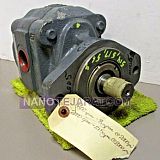
 | |
| hydraulicmarket | 021-55130771 |
| hydraulicmarket |
| Iran |
| 021-55130771 |
KATO crane hydraulic pump repair
The sale and repair of hydraulic pumps for KATO cranes, especially models using Uchida pumps, require high technical expertise. These pumps, such as A10VD43SR and AP2D36, are used in heavy-duty KATO cranes like the HD307 and NK1200. Sourcing these parts from reputable international suppliers such as Alibaba and Made-in-China is feasible. To ensure quality and authenticity, selecting suppliers with proven track records and positive customer reviews is recommended.
For repairing Uchida hydraulic pumps, companies like Hydraulex and Rexton Hydraulic provide specialized services. These companies use experienced technicians and advanced equipment to rebuild faulty pumps according to OEM standards. Hydraulic pump repair demands precision and technical experience to maintain optimal crane performance. If local services are unavailable, shipping the pump to these centers can be a suitable option.
For spare parts supply and repair services in the Middle East, collaborating with official KATO dealers or reputable companies in neighboring countries like the UAE and Saudi Arabia is advisable. These companies typically have access to original parts and specialized technical support. For further consultation or detailed information, contacting these authorized representatives is recommend
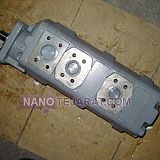
 | |
| hydraulicmarket | 021-55130771 |
| hydraulicmarket |
| Iran |
| 021-55130771 |
Komatsu WA800 hydraulic pump repair
The hydraulic pump of the Komatsu WA800 wheel loader is typically an axial piston pump with a swash plate design, capable of operating at pressures up to 350 bar. This pump supplies the required oil flow for the hydraulic system, including the boom and bucket cylinders. The original brand used in this machine is usually Komatsu or Kobe, both recognized for their high durability and performance under demanding mining conditions.
The flow capacity of the WA800 hydraulic pump varies between 750 and 900 liters per minute at the rated speed of 1800 rpm, depending on the specific model. Such a high flow rate ensures smooth and responsive operation of hydraulic components such as lift cylinders and the steering system. The optimized internal oil passages are engineered to minimize pressure losses, thereby improving overall hydraulic efficiency.
The overhaul process of the WA800 hydraulic pump includes inspection of the cylinder block, replacement of pistons, evaluation of the swash plate, and control of internal bearings. Wear tolerances in these components are generally kept below 0.02 millimeters to maintain optimal efficiency. After reassembly, a performance test at 300 bar pressure and the nominal flow rate is required to verify leakage-free operation and stable performance.
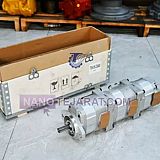
 | |
| hydraulicmarket | 021-55130771 |
| hydraulicmarket |
| Iran |
| 021-55130771 |
Toyota forklift hydraulic pump repair
Repairing the hydraulic pump of a Toyota forklift involves accurately diagnosing faults, disassembling the pump, and inspecting internal components such as the rotor, gears, and O-rings. Before repair, the hydraulic system should be drained and filters replaced to prevent contamination. Using pressure and flow measurement tools for numerical diagnostics ensures precise fault identification and reduces the risk of recurring pump failures.
Toyota hydraulic pumps are typically gear-type or piston-type with operating pressures between 150 and 180 bar and flow rates of 45 to 75 liters per minute. The original TOYOTA brand, whether domestic or OEM, provides high-quality materials and assembly. Key numerical specifications include pressure tolerance, volumetric efficiency, and maximum designed flow, which are critical for operating lift cylinders and hydraulic steering systems.
During the repair process, special attention must be paid to worn gears, bushings, and internal components. Using standard hydraulic oil, replacing worn parts, and testing pressure and flow after reassembly restores the pump’s performance to factory specifications. This process ensures the Toyota forklift hydraulic system operates safely and efficiently at full capacity.
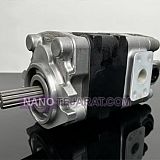
 | |
| hydraulicmarket | 021-55130771 |
| parsianrahbalandeh |
| Iran |
| 02155130771 |
CNC hydraulic pump repair
Repairing a gear-type hydraulic pump for a CNC cutting machine involves disassembling the housing, inspecting gear and shaft wear, and replacing pressure O-rings. Common pump codes include PV2R, PVM, and GPV, which operate reliably in CNC connections under 140–210 bar pressure. ISO VG 46–68 hydraulic oil is typically used to reduce wear and maintain pump precision. Inspecting seals and gaskets prevents internal leakage and pressure drops. Adjusting gear clearance and checking bearings extends pump life up to 5000 operating hours. The pressure gauge on the outlet line should show less than a 5-bar deviation from the manufacturer’s standard.
Consumable parts include gears, shafts, O-rings, and high-pressure seals, usually made from steel with 55–60 HRC hardness. Common failures include gear wear, shaft corrosion, and seal cracking. During repair, thorough oil flushing and debris inspection are essential. Operating pressure should be 120–210 bar with a volumetric flow of 20–60 liters per minute within ±3% accuracy. Shaft vibration above 0.5 mm indicates imbalance and requires realignment. Pump operating temperature should not exceed 75°C.
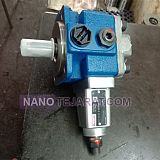
 | |
| parsianrahbalandeh | 02155130771 |
| hydraulicmarket |
| Iran |
| 021-55130771 |
Volvo L150E loader hydraulic pump repair
The Volvo L150E loader hydraulic pump is a critical and complex component for optimal machine performance. It is a variable displacement piston pump with a load-sensing system that adjusts flow and pressure according to demand. The pump delivers a flow rate of approximately 47.6 gallons per minute about 180 liters per minute, and its relief valve is set to 3626 psi around 250 bar.
During repair of the L150E hydraulic pump, the system pressure must first be fully released. The pump is then removed using appropriate tools, and its internal components are inspected. Worn parts such as pistons, valves, and O-rings are replaced if necessary, and after reassembly, the pump undergoes functional testing to ensure proper operation.
Replacement parts for the L150E hydraulic pump can be sourced from reputable suppliers like FridayParts. Compatible part numbers include VOE11709023 and VOE15068638, which also fit models L150F, L180E, L180F, and L220D. Using genuine parts ensures reliability, efficiency, and longevity of the hydraulic system.
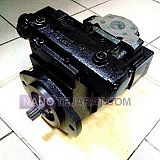
 | |
| hydraulicmarket | 021-55130771 |
| parsianrahbalandeh |
| Iran |
| 02155130771 |
volvo loader L90 rexroth hydraulic pump repair
Repairing the Volvo L90 A10VSO hydraulic pump begins with fully disassembling the housing and removing the rotor, pistons, and rear plate. Rotor and main shaft surfaces are measured with 0.05 mm precision to detect wear or misalignment. Pistons and springs are inspected and replaced if cracked, worn, or broken. All seals and O-rings are replaced to prevent hydraulic leaks. Components are cleaned with specialized hydraulic solvent, dried, and prepared for reassembly.
Assembly starts with precise installation of the rotor in the housing and alignment of the rear plate. Shaft torque and preload are adjusted to achieve 40–50 MPa operating pressure. Flow rate and volumetric efficiency are measured on a test bench at 2200–2500 rpm. Common issues include excessive noise, reduced output pressure, and internal leakage, which are resolved by replacing worn parts and accurate shaft alignment.
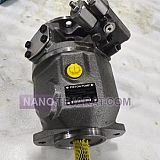
 | |
| parsianrahbalandeh | 02155130771 |

